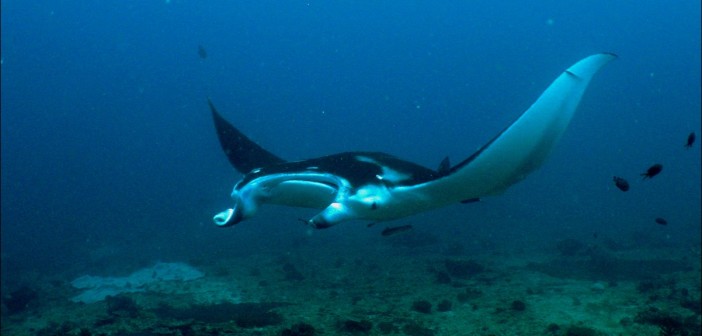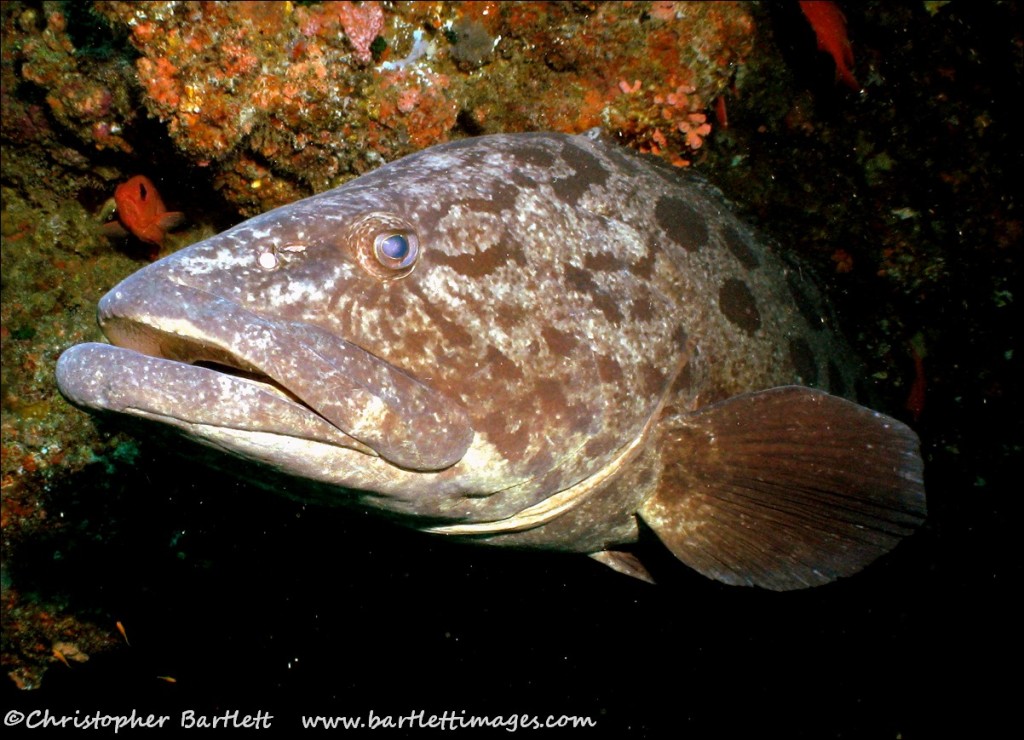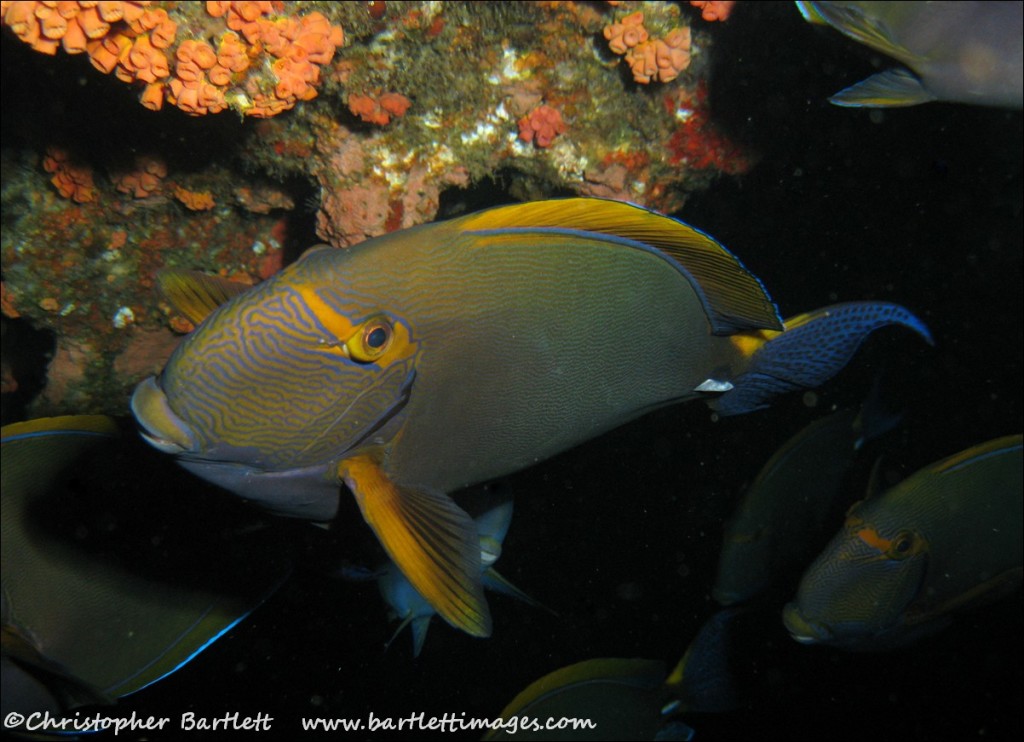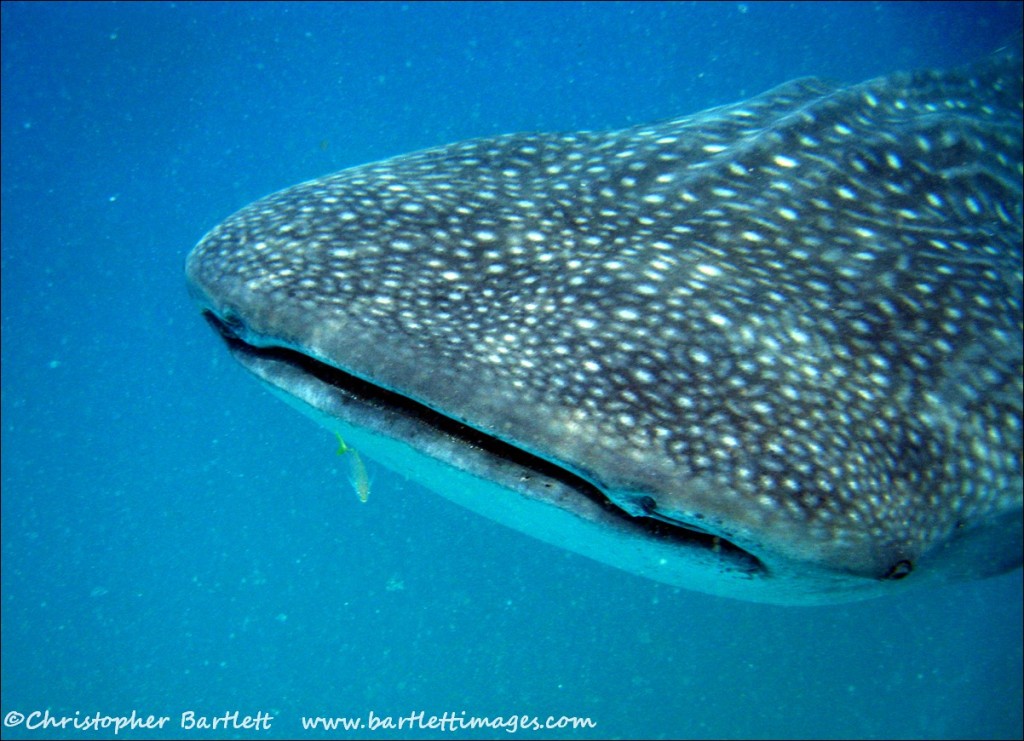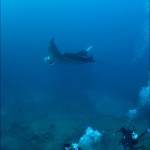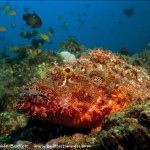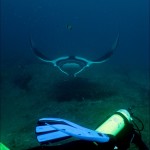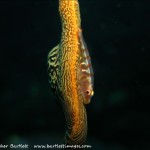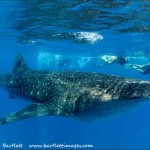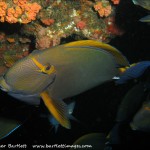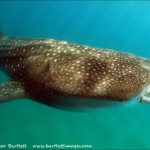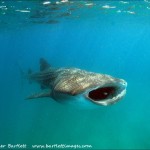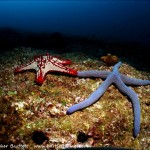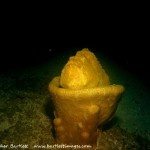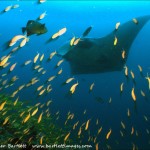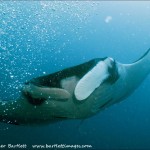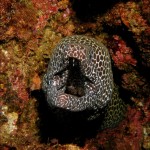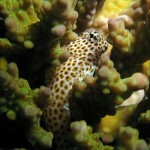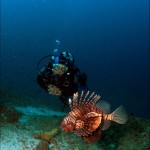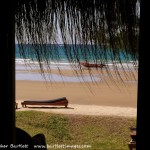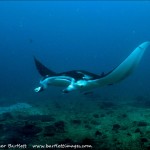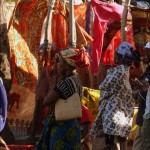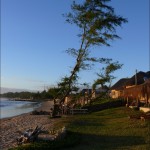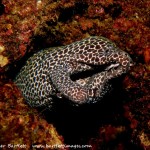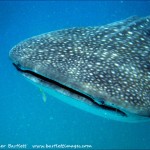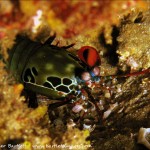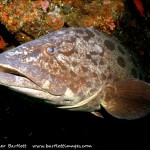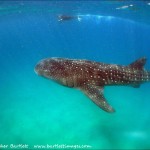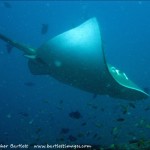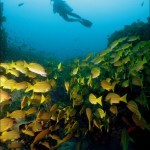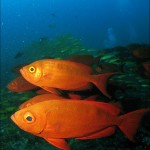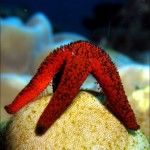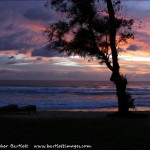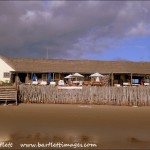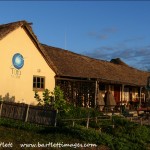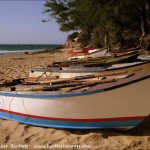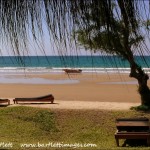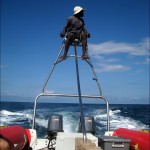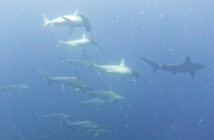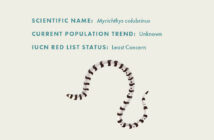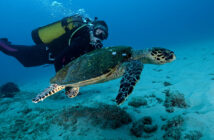“Hold her straight!” shouted John over the surf. “Ladies on! Hold the nose and keep going!” he encouraged as the skipper jumped on and fired up the twin 85s. “OK, jump on!” Pulling myself along the boat from the nose until my feet touch the sand again I pushed off the bottom and heaved on the side rope, popping onto the pontoon of the RIB. “Feet in foot straps and hold on to the rope” dive guide Carlos reminded us as the RIB surged forward looking for a gap in the rolling surf.
Every launch is like this here, some days are relatively sedate, others provide more fun as the wind and swell make holding the bow like a rodeo. Personally I think surf launches are a great start to the day. Past the backline and the last breakers, we relaxed and zipped across the Indian Ocean parallel to the Mozambican dune-covered coast to our first dive site.
Rolling backwards off the pontoon of the RIB, I delighted in the slow-motion freefall from a negative entry, going straight down with Carlos. “At last” I thought, “this is the life”. Yet I had little time to contemplate the hue of the blue and the visibility, as the instant I looked down I saw a giant manta moving slowly over the cleaning station 20 metres below. It slid graciously and effortlessly through the water, butterflyfish, goldies, and wrasses nibbling it clean of the parasites it had picked up on its oceanic wanderings. We unobtrusively dropped behind a wall next to the cleaning station and watched as a second and then a third manta glided in, whilst a large green turtle settled into a hollow. What a start!
As we drifted gently along the dive site, the oddly-named Hogwarts, 100 kilos of potato grouper gave us the eye, kingfish motored past, and a school of barracuda zipped along. My grin was so wide I nearly lost my regulator when a unique small-eyed stingray, the largest of all stingrays and only ever seen alive here, 5000 kilometres from the edge of its previously considered range, flapped its two-metre wide wings and slid past nonchalantly. It was undoubtedly the best first dive of a trip ever, and there were some big smiles on the surface, dive leader Carlos beaming even more than normal.
As we closed in on the beach the novices were reminded to hold themselves down on the pontoon as the RIB was beached at high speed. Even after the 100th time it feels like a commando operation and there is a frisson of anticipation waiting for the bump as the boat leaves the sea and rides up the sloping beach to escape the breakers.
450 kilometres north of Maputo, Mozambique’s capital, and half an hour from the historic Portuguese trading town of Inhambane and it’s airport, Tofo is a laid-back village popular for its endless pristine beaches and, of course, SCUBA diving. The warm waters of the Indian Ocean provide sustenance for an abundance of marine life here, but the mantas and the whale sharks are the stars of the show.
On the boat after the first dive, the crew changed our cylinders and we moved close to the coast and started cruising slowly, looking for the biggest fish in the ocean, the beautiful and docile whale shark. Within an hour skipper Ernesto’s eagle eye picked out the outline of one of these giant planktivores. Donning fins and masks we slid over the side and snorkelled alongside a six-metre specimen, the sun’s rays highlighting the white spotted patterns that cover its body from the tip of its tail to its super-wide terminal mouth.
Attracted by the plankton blooms that occur in the vicinity, Junior opened wide to filter out the nutrients with the spongy tissue near its gill arches. As we did our best to keep up, he progressed effortlessly seemingly not moving his tail at all, staying just below the surface for 10 minutes, before he disappeared from view.
And Junior is not alone; according to research scientist and Whale Shark specialist Dr Simon Pierce, Tofo has the world’s largest population of the species, present year round, making it an ideal place for a sighting or two. Non-divers can also enjoy an amazing encounter with this behemoth on a two-hour ocean safari run by Tofo Scuba. I swam with them on four occasions in 14 days of diving. Not bad considering that seven of thise days were spent visiting sites to the north that are not in the vicinity of whale shark action.
There are three dive centres in Tofo, with similar prices, but Tofo Scuba (www.tofoscuba.co.za) has an attractive, purpose-built dive centre on the beach, a training pool, an on-site restaurant, and very professional and friendly staff. They are an eclectic mix of nationalities who make you feel at home straight away, and with smiles everywhere it is impossible to not have a good time. The rates are the best in town too: On a 10-dive package with your own equipment, a dive comes to a very reasonable 22 pounds. Some of the further reefs are subject to a small surcharge, but are well worth it.
To the north, Amazon with its strong currents has a good mix of macrolife, lionfish, honeycomb morays, and groupers, and never has it such a pleasure to be informed that it is time to go to The Office. Michael Scott was happily absent but his chair is often filled by a leopard shark, some whitetips, and the wierdly beautiful bowmouth guitarfish. Colosseum is another northern site and has only ever been dived a handful of times but should be renamed The Hospital for its schools of eye-stripe surgeonfish.
Straight out of the bay lies Giant’s Castle. Dropping next to a Manta cleaning station, we drifted along the battlements as spectre-like silhouettes appeared from the blue, before dropping down to find the crawling sea moth or short dragonfish, morays, and ribbon eels. Often the second dive of the day, it has a relatively short bottom time despite a 90-minute surface interval, but it’s an action packed half-hour. As the bottom sloped downwards, peppered with green coral trees, a large school of pelagic big-eye jacks cruised into view circling us for a minute, and as we rose to our safety stop a school of devil rays ambled past. Giant’s also seems to be a favourite haunt of the small-eye stingray and I was fortunate enough to see it there on two occasions.
To the south, next to the impressive Hogwarts, lies the jewel in Tofo’s crown. The aptly-named Manta Reef is a vibrant piece of underwater eye candy that I would happily dive over and over. From the surface swathes of yellow and striped snapper, red soldierfish, and blue red-fang triggerfish covering the pinnacles can be seen. Dropping into an ampitheatre that starts at 18 metres and bottoms out at 28, it is impossible to know where to look. Whilst taking in the stunning colours of the schooling fish, my eye is caught by a coral whip goby, and then I spy African and Potato Grouper under different overhangs. Back over the edge of the wide bowl, countless mantas (the resident and world-leading manta researcher Dr Andrea Marshall, identified 22 different individuals there the previous day), both giant and “normal”, glided gracefully over the numerous cleaning stations, as a myriad of goldies, damsels, and butterflyfish picked them clean. They danced over us, around us, and even between us, as if courting each other. I was certainly smitten. And that was before meeting the monster.
I have seen many a fair-sized giant moray, as thick as a large man’s head, but, standing proudly on one-third of its three metres at the back of a cave like a dragon in its lair, was a beast with a head the size of a horse. Unsurprisingly I could not convince my buddy to go in with a torch to help me focus my camera and give a sense of scale, but the image of this goliath of morays will stay with me until I return, as return I will. Manta Reef is definitely up there with the best.
Tofo has a range of accommodation options from camping to lodges, but right next to the dive centre the independently owned and run Aquaticos Beachside Casitas provide conveniently located, good value for money self-catering with friendly staff who take care of dishwashing and free laundry to boot. A short walk along the beach or sand roads to the market and several restaurants and bars, and an even shorter walk to Tofo on-line for email junkies, or to Dino’s bar for pizza or prawns, everything is close by. Meals at Tofo Scuba, Dino’s, or Fatima’s go for around 8 USD, a pizza will set you back 10 USD. Coraciida is a new place on the other side of the dive shop that costs 72 euros per double per night and Casa do Mar in the centre of the village is arguably the most upmarket place to stay and a double costs $160 USD per night for the room.
The market has fresh fruit and veg, cashews, fish, and basic groceries, and, hidden in the centre behind the colourful batiks, some local lunch eateries serving rice with fish, chicken, or beef cooked on coals for a dollar fifty. If your Portugese or Bitongo isn’t up to much, pointing at a pot and saying “que es, por favor?” will get you a look inside. In the evening ask for Mr Bamboo’s for grilled chicken or fish with a mountain of rice and fresh tomato salsa and wash it down with a 500 ml Manica, a Dois M, or Mozambique’s stout, Laurentina Preta, and you’ll get change from five USD.
It’s perfectly safe to walk around day or night, and the curiously squeeky sand is a delight to stroll along. Just remember to pack the sunscreen, as even in early May the air temperature is in the low thirties, and the sea at 25-27C, although it can drop to the low twenties in July.
As I write this in the bus heading south, taking in the palm trees, acacias, and the villages with cassava crops and roadside vendors, I wonder when I’ll be back. Tofo and its megafauna have enchanted me.
LAM fly between Inhambane and Johannesburg on Mondays, Wednesdays, Fridays, and Sundays, or it’s an eight-hour ride on a shuttle bus departing from outside Fatima’s in Maputo at 5 a.m everyday. The cost is around 16 USD and there is more information at www.mozambiquebackpackers.com. The LAM ticket office is difficult to deal with and it’s best to go through an agent like Indigo Safaris www.indigosafaris.com. They deal with a range of accommodation providers in Tofo and can build in a land safari in the Kruger National Park in South Africa too. A Johannesburg-Inhambane return is around 500 to 600 USD.




